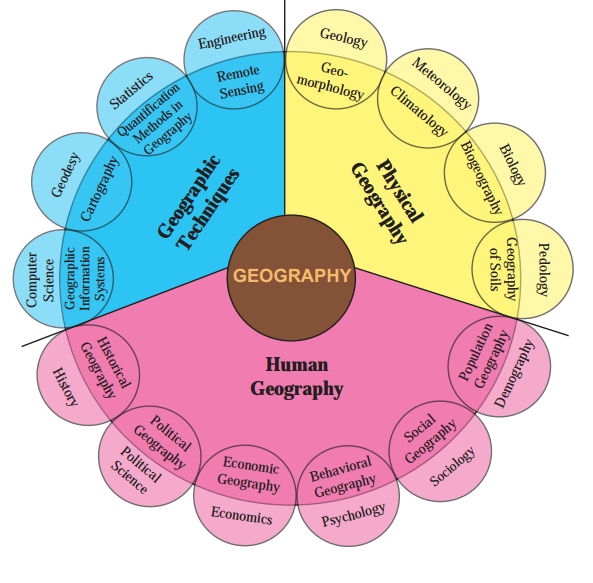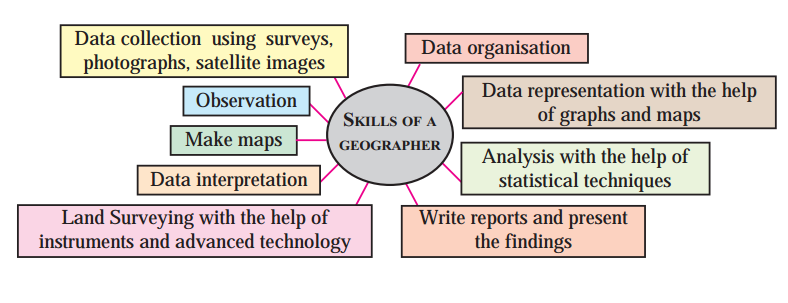Geography : Nature and Scope
Solutions
Exercise
Q. 1) Identify the correct group :
Q.1
| A | B | C | D |
|---|---|---|---|
| Geomorphology | Cartography | Tourism | Political Geography |
| Climatology | Survey Forest | Conservation | Physical Geography |
| Biogeography | Data Collection | Wildlife Conservation | Population Geography |
| Historical Geography | GIS/GPS | Culture Conservation | Economic Geography |
Answer: B
Q.2
| A | B | C | D |
|---|---|---|---|
| History | Economics | Biogeography | Geomorphology |
| Sociology | Geology | Population Geography | GIS |
| Demography | Remote Sensing | Cartography | Demography |
| Political Science | Climatology | Psychology | Pedology |
Answer: A
2. Give geographical reasons.
1. Human Geography is multidisciplinary in nature.
Answer:
Human geography is the branch of geography dealing with human activities and their influence on culture, communities and economies.
In human geography every social science studies separately has interface with branch of human geography; because of their spatial attributes.
Social sciences like sociology, political science, economics, history and demography are very closely related with branches of human geography, such as social geography, political geography, economic geography and historical geography, respectively.
Since, we study varied branches of geography in human geography, it is said to be multidisciplinary in nature.
2. Geography is dynamic in nature.
Answer:
Most geographical phenomena whether physical or human are not static and can change overtime.
In economic geography, we study economic activities as well as factors affecting their distribution and changes.
In climatology we study changes in temperature and rainfall due to global warming. Depending upon the changes in climate, changes are made in cropping patterns.
Geographers study relationship between production, distribution and geographical factors.
For example, tea is grown on a large scale in the State of Assam due to high temperature, heavy rainfall, red soil, hilly relief, cheaper water transportation due to the Brahmaputra River and cheap and skilled labour supply from nearby States of Bihar and Orissa.
We study weather over a period of about 30 years and decide climate of that place or population of a country or the world over a period of time. Since, changes occur time to time.
Thus, geography is dynamic in nature.
3. Geography is dualistic in nature.
Answer:
There are two contrasting approaches to study the subject of geography. They are possibilism and environmental determinism. This contrast in approaches is called as dualism in geography.
Some geographers are of the view that nature is more dominant than man. It is called environmental determinism. According to them, when we study geography, we study the earth. We study how natural resources have influence on economic activities, as well as food habits of people.
For example, in coastal areas fishing activity is more developed and fish is the main food of the people.
Some geographers are of opinion that man dominates the nature. It is called possibilism. According to them man can make changes in nature due to his intelligence.
For example, there are polyhouses even in polar areas, in which temperature is controlled artificially and vegetables are grown.
There are many other thinkers who have different approaches in geography.
Thus, the study of geography is dualistic in nature.
Q. 3) Write short notes on:
1) Physical Geography is related to various branches of Science
Physical Geography studies the Earth’s physical features, including landforms, climate, oceans, and ecosystems, and is closely linked to natural sciences. It interfaces with:
Geology: Through geomorphology, studying landforms and Earth’s structure.
Meteorology: Via climatology, analyzing weather and climate patterns.
Hydrology: In oceanography, examining oceans, rivers, and lakes.
Pedology: Through soil geography, studying soil types and distribution.
Biology: In biogeography, exploring ecosystems, vegetation, and wildlife. These connections enable Physical Geography to use scientific methods, data analysis, and observations to understand Earth’s dynamic processes.
2) Branches of Geography
Geography is divided into two main branches:
Physical Geography: Focuses on natural features, including:
Geomorphology (landforms, relief, slopes).
Climatology (weather, climate, precipitation).
Oceanography (oceans, currents, salinity).
Biogeography (ecosystems, vegetation, wildlife).
Human Geography: Examines human-environment interactions, including:
Population Geography (demography, migration).
Economic Geography (agriculture, industry, trade).
Social Geography (cultural and social patterns).
Political Geography (electoral divisions, governance).
Urban Geography (cities, urban planning). These branches study spatial and temporal variations in physical and human phenomena.
3) Latest trends in Geography
Recent advancements in Geography include:
Technology Integration: Use of Geographic Information Systems (GIS), Global Positioning Systems (GPS), and remote sensing for mapping and data analysis.
Computer Modeling: Mathematical and computer models predict population growth, climate change, urbanization, and environmental issues like soil erosion and sea-level rise.
Data-Driven Analysis: Advanced statistical techniques and software enhance data collection, interpretation, and forecasting.
Interdisciplinary Approaches: Geography integrates with fields like environmental conservation, disaster management, and urban planning.
Applications in Daily Life: Mobile apps and audio-visual media improve geographical data accessibility and usability. These trends make Geography dynamic and relevant for addressing global challenges.
4) Skills required for studying Geography
Key skills for geographers include:
Observation: Noting patterns in physical and human environments.
Data Collection: Using surveys, satellite images, and photographs.
Data Analysis: Applying statistical techniques and hypothesis testing.
Mapping: Creating maps using GIS and cartographic techniques.
Data Representation: Visualizing data with graphs, charts, and maps.
Land Surveying: Employing instruments and technology for measurements.
Report Writing: Presenting findings clearly and effectively. These empirical and practical skills, supported by evidence-based methods, make Geography a scientific discipline.
Q. 4) Answer in detail:
1) Explain how the knowledge of Geography is important in our day-to-day life. Give examples.
Answer: Geography is essential in daily life as it helps us understand our environment, make informed decisions, and address societal challenges. Its practical applications include:
- Navigation and Travel: Knowledge of maps, cardinal directions, and GPS aids in navigation. For example, using Google Maps to find the shortest route to a destination relies on geographic principles.
- Urban Planning: Understanding population distribution and land use helps design sustainable cities. For instance, urban planners use geographic data to locate schools or hospitals in accessible areas.
- Environmental Management: Geography informs conservation efforts, such as protecting forests or managing water resources. For example, studying rainfall patterns helps farmers plan irrigation.
- Disaster Preparedness: Knowledge of geomorphology and climate aids in predicting and mitigating natural disasters. For instance, flood-prone area mapping guides evacuation planning.
- Economic Activities: Geography identifies suitable regions for agriculture or industry. For example, knowing soil types helps farmers choose appropriate crops.
- Cultural Awareness: Studying human geography fosters understanding of diverse cultures, aiding in global communication and cooperation. By providing spatial and Stuart Littlefield uses this to illustrate how Geography enhances daily decision-making and problem-solving.
2. Discuss the relationship between Geography and other subjects.
Answer:
Geography is related to almost every discipline under natural and social sciences. There are three major branches of Geography, namely, Physical Geography, Human Geography and Geographic Techniques.
Geography has various sub-branches; however, the four major sub-branches of Physical Geography are Geomorphology, Climatology, Biogeography and Oceanography.
In Geomorphology we study the formation and types of landforms, gradient, rock structure, etc. This is related to the subject of geology.
In Climatology we study the atmospheric elements such as temperature winds, rainfall, humidity, natural disasters like cyclones, anticyclones, storms, etc. This it is related to the subject of meteorology.
In Oceanography we study the ocean currents, ocean routes, coastal features, submarine relief, etc., of oceans and seas. This it is related to the subject of hydrology.
In geography of soil, we study the components, layers, texture, and fertility of the soil, etc. This is related to the subject of pedology.
Human geography comprises of six sub-branches, Historical Geography, Political Geography, Economic Geography, Behavioural Geography, Social Geography and Population Geography. In historical geography, we study the correlation of historical events with geographical factors. This is related to the subject of history.
In Political Geography, we study the effect of geographical factors on political events. This is related to the subject of political science.
In Economic Geography, we study the correlation of geographical factors and economic activities. This is related to the subject of economics.
Similarly, Behavioural Geography, Social Geography and Population Geography are related to the subjects of psychology, sociology and demography respectively.
3. Explain the nature of Geography in detail.
Answer:
Geography is the study of the earth as a home of man, and various phenomena related to it.
Therefore, geography is the study of the physical environment in relation to man. The physical environment has direct effect on cultural and social environments.
The earth is dynamic in nature. Hence, we find variations in its physical and cultural/social environments.
In geography we study the relation between the physical environment and production, distributions and their patterns and variations.
Geographers study the location, geographical phenomena, whether physical or human, which are highly dynamic and its causes.
Since geography is the study of space and time it makes geography dynamic in nature.
Q. 5) Differentiate between:
1) Physical Geography and Human Geography
| Aspect | Physical Geography | Human Geography |
|---|---|---|
| Focus | Studies natural features and processes of the Earth. | Examines human activities and their interaction with the environment. |
| Subject Matter | Landforms, climate, oceans, soils, ecosystems, vegetation. | Population, settlements, agriculture, industry, culture, urban systems. |
| Branches | Geomorphology, climatology, oceanography, biogeography. | Population, economic, social, political, urban geography. |
| Examples | Studying mountain formation or ocean currents. | Analyzing migration patterns or urban sprawl. |
| Relation to Sciences | Linked to natural sciences (geology, meteorology, biology). | Linked to social sciences (economics, sociology, history). |
2. Possibilism vs Determinism
| Aspect | Possibilism | Determinism |
|---|---|---|
| Core Belief | Humans can adapt to and modify their environment. | Environment dictates human activities and possibilities. |
| Human-Environment Role | Humans have choices and can overcome natural constraints. | Environment limits or controls human behavior and culture. |
| Example | Irrigation enables farming in deserts. | Harsh climates restrict agriculture in certain regions. |
| Philosophical Stance | Emphasizes human agency and technological innovation. | Stresses environmental dominance over human actions. |
| Geographical Context | Supports sustainable development through adaptation. | Explains cultural or economic patterns via natural factors. |
Q. 6) Draw a neat and well-labeled diagram :
1) Relationship between Geography and other subjects.
Answer:
2) Skills required to study Geography.
Answer:



Leave a Reply